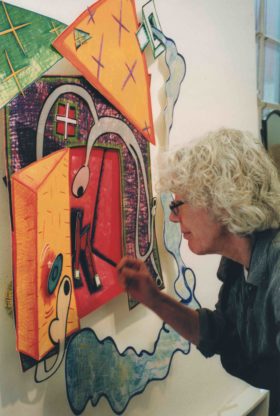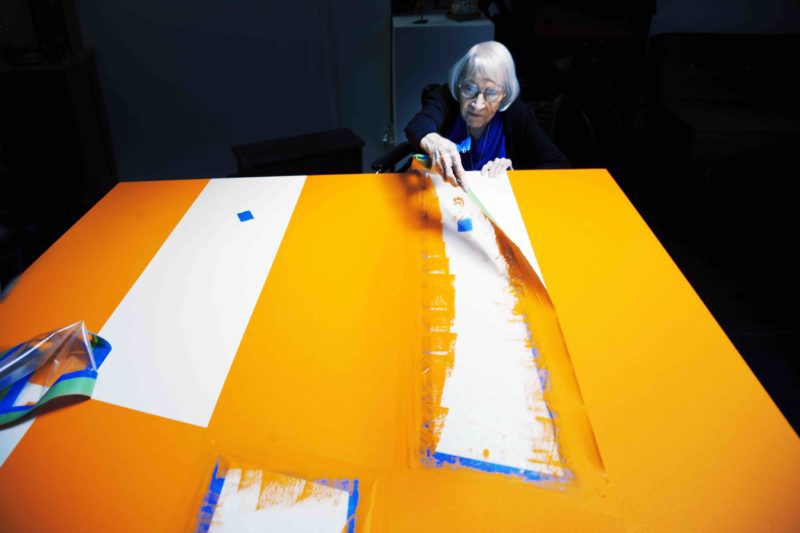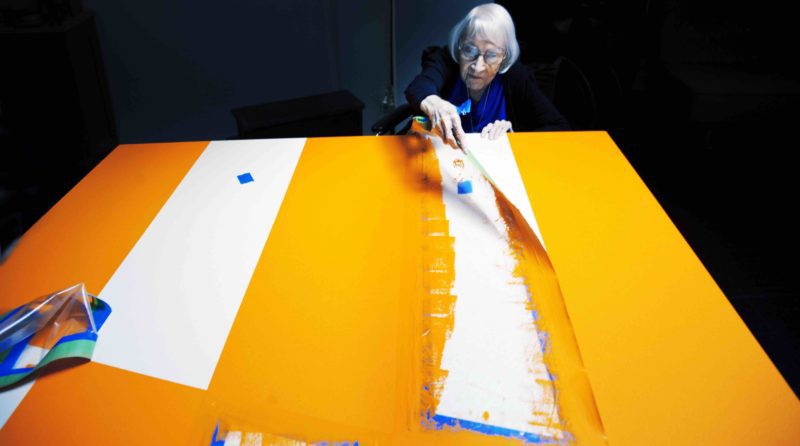INTERVIEW: Docs on Carmen Herrera, Elizabeth Murray premiere at Film Forum

Film Forum recently premiered two poignant documentaries on the remarkable and immensely talented painters Carmen Herrera, a 101-year-old Havana-born artist who lives in New York City, and Elizabeth Murray, the groundbreaking and influential artist whose pieces still generate discussion today. Although both of these subjects are different and didn’t work directly in the same circles, there is a commonality in their life’s stories.
Everybody Knows … Elizabeth Murray details the gender bias Murray encountered in an art world dominated by white men, and The 100 Years Show, which documents Herrera’s late-career resurgence, touches upon the artist’s inability to gain recognition even as her male peers earned notoriety and lucrative sales.
“I was still traveling with my first film, Ai Weiwei: Never Sorry, and I was showing it at the AGO [Art Gallery] in Toronto,” said Alison Klayman, director of The 100 Years Show. “Some folks from Lisson Gallery who also work with Ai Weiwei were there. … I was living in New York, and I was about to move to Tokyo for my then-boyfriend’s work. And they said, ‘You know, you should meet Carmen if you’re in New York before you go.’ So it was like two weeks before I was about to leave the city.”
Klayman visited Herrera at the artist’s apartment in Manhattan, and almost instantly the director felt she was a person who deserved a movie about her life. Klayman felt her own life would be enriched by spending time with Herrera, and The 100 Years Show began.
“I really also felt like there was a lot of questions I had that I wanted answered,” Klayman said. “I found it personally really challenging and interesting to know more, so I just started filming with her. Bad timing in a way that I was about to not live in the same city but be far away, but I just came back every couple of months. I was really committed to having something to show for her 100th show, and now she’s 101. She’ll be 102 in May.”
Herrera is having many memorable moments on the art scene in the United States. The Whitney recently closed a celebrated exhibition titled Carmen Herrera: Lines of Sight, and The 100 Years Show promises to bring even more recognition to the colorful and precise geometric paintings Herrera has been creating for some time.
The artist doesn’t leave her apartment much. In the film, she is seen working with assistants and enjoying good times with friends and neighbors. However, because the elevator is not working in her building and her constant work on canvases, Herrera stays put in her home, making it a true “studio” apartment. These tight quarters presented an obstacle to Klayman’s filming.
“I definitely saw that as a challenge,” Klayman said. “Carmen really didn’t leave her apartment the entire time that I was filming. The space is small, but I think that just necessitated a kind of intimate filming. … I mean, I’ve directed projects with bigger crews, but also I like to film and be able to develop a very intimate rapport. And I think with this one, it was super necessary, but to me it was a challenge visually and also editorially the fact that we weren’t going to see her go in different places. Luckily there were these amazing wealth of photos, but there really wasn’t video of her, archival video. So, yeah, I think that was a challenge, and I really just wanted to make sure that the film felt as lively as she was and not be hindered by the limitations.”
Kristi Zea, the director of Everybody Knows … Elizabeth Murray, has a different story of how she came to know Murray, an artist who reinvented her style and is perhaps best known for her augmenting of canvas shapes for large, interconnected works of art. To understand the backstory, one needs to appreciate Zea’s accomplishments in the movie business. She is a sought-after production designer who has been nominated for Academy Awards and worked with some of most visionary directors in the history of cinema. These connections, in a roundabout way, led her to Murray.
“I’m a production designer for motion pictures, sort of major commercial motion pictures, and Jonathan Demme and Martin Scorsese are both people who I’ve worked with,” Zea said. “Jonathan loves to do documentaries, and he’s been doing great ones over the years but particularly with Neil Young being the subject matter. And Martin Scorsese also does great docs, and he had done one on Dylan, Bob Dylan. And so I thought to myself, gee, you know, I would really love to be able to do a movie about a woman artist and bring her in the same kind of spotlight as Jonathan and Scorsese have done for these two wonderful musicians.”
At the time that she had this idea — but no documentary subject in mind — she began embarking on another project that she called a “Mormon opera.” She traveled to Utah to conduct some research, and on the second trip to the western state, the team brought some acquaintances for the journey. One of those people, who became a fast friend, was Murray.
“She and I met on one of these trips, and that was about, God, it was probably about 30 years ago,” Zea said. “So we had lots of time to get to know each other, and at some point, either on the first, or second time or third time we all went out there, I said to Elizabeth, ‘You know, I’d really like to do a documentary about you. How do you feel about that?’ She said, ‘I’d love that.’ So she then gave me names of all these people who I should interview, and we embarked on the whole process, which actually was something I didn’t really know what I was going to find out about her necessarily. But as I started to interview all these people, it became very clear to me that, number one, she was loved by everybody. Number two, very ambitious, very driven artist, but also one of the nicest people I’ve ever met, and also sort of facing the same kind of dilemmas that I was facing in regards to trying to juggle being a parent, being a wife and also pursuing a career as an artist. So all of these things resonated with me, and so we just started on it.”
Some of the people Zea talked to for the film included Roberta Smith, Paula Cooper, Jennifer Bartlett and Vija Celmins, all “art world luminaries,” as Film Forum puts it. The positivity that Murray exuded was obvious and confirmed by her friends and peers. However, the documentary also takes a sad narrative turn after Murray became seriously sick during the filming process.
“We found out that she was sick, which was a big surprise and made the film a very different kind of film than it was when we first started,” Zea said. “Also very soon thereafter was this very large and very wonderful retrospective of her work at MoMA, so I just started filming.”
Zea was able to capture not only the life and legacy of Murray, but also the artist’s thoughts on her family, her work, her opportunities, her setbacks and her final days. The director spent a lot of time with the artist, detailing her acceptance into the Paula Cooper Gallery and her eventual move to Pace Gallery.
“People understood why she would want to do something like that,” Zea said of Murray’s change in gallerists. “I mean the art world, as all worlds, has ups and downs, and I think to a certain extent she went where she felt she needed to go. And she wanted to play with the big guys. She wanted to be in the same arena as them, and at the time, that was why she moved to Pace. So I think she wanted to be an artist that was recognized, and she wanted to stay in the game. But she also wanted to be able to continue her life as she wanted it with children, even when she was in her 40s.”
Zea said that Murray was aware of the difficulties of being a woman in a male-dominated profession. The artist didn’t want to be marginalized, and she didn’t like the idea of showcasing her work in a show of all women. “We don’t say male artist, do we?” Zea asked. “There is a qualifying nature too still even today, and I thought it was pretty ironic that The New York Times, when she had the MoMA retrospective, the headline was ‘MoMA’s … First Grandmother.’ … So I think that there’s always going to be an issue about this. It’s still to this day an issue, but I think during the course of her life she was battling it fairly constantly.”

Klayman found parallels between Murray and Herrera’s acceptance, or lack thereof, in her own film.
“I also don’t think she didn’t fit the mold for what was ‘Cuban art,’ and I think women art, there probably wasn’t really any value to being seen as a woman artist,” Klayman said. “It’s not like, oh, then you’ll get into that show. … That wasn’t going to get you there somewhere special. What I think is interesting, the story in The 100 Years Show where she tells one anecdote, which she tells often about pretty much overt discrimination of not being in a show from a woman gallerist. I think the deeper backstory to that, or the deeper context to that, is that sometimes women might have been denied an opportunity specifically because they were a woman, and they were seen as we have to give the opportunity to a man because the men are providing for their family. The idea that, oh, I have men on my roster, and they really need the work. Then I can see the assumptions that follow, or that it wasn’t as urgent financially for a woman artist.”
Zea pointed out that many of the issues that are brought up in the two documentaries are still present today in the art world and overall professional world.
“We’re still grappling to this day with how to manage a personal life, a life as a wife, a life as a mother, and also what we need to do for our own professional side,” Zea said. “I think now it’s a little bit easier, but we’re still trying to figure out how to make it work. I think Elizabeth was very lucky because her husband, Bob Holman, was around and could pick up the slack. She wanted to have more children, and she had them when she was in her 40s. As you see in the film, she wanted it all, and, frankly, she did get it all. She needed to do what she did, and she had a studio right next door to her living quarters. But when she was in there, no one was allowed in when she was actually working. Bob said that to me on occasion, that when she was in that room, you let her do her thing, but by the same token, the kids were always around. All of the archival footage that we have in the film shows that, that they’re very much present, and bicycling through the studio, and having their own paint set and everything else. It’s definitely a juggling match.”
Klayman added on Herrera: “It’s not because she’s a woman artist we have to talk about her husband, or we have to talk about family. The films about male artists that don’t delve into the women that supported them, the family that supported them, the children and their relationship they had with various children, I mean there’s something missing there. And the idea of being an auteur, a singular visionary, I mean you have to eat. You have to afford rent, or you don’t. And there’s a reason why, and I feel like that is equally as instructive to a lot of aspiring artists or artists who are toiling away and hoping for recognition. … I knew that they would look to this film and have found inspiration from The 100 Years Show and from Elizabeth Murray, and I think part of the thing is how do you do it. It’s not just about the accolades or the show you get; it’s also what do you do in the in-between times. There’s a broader story that does involve life, family, income, balance.”
By John Soltes / Publisher / John@HollywoodSoapbox.com
Everybody Knows … Elizabeth Murray and The 100 Years Show are playing on a double bill at New York City’s Film Forum. Click here for more information and tickets.

